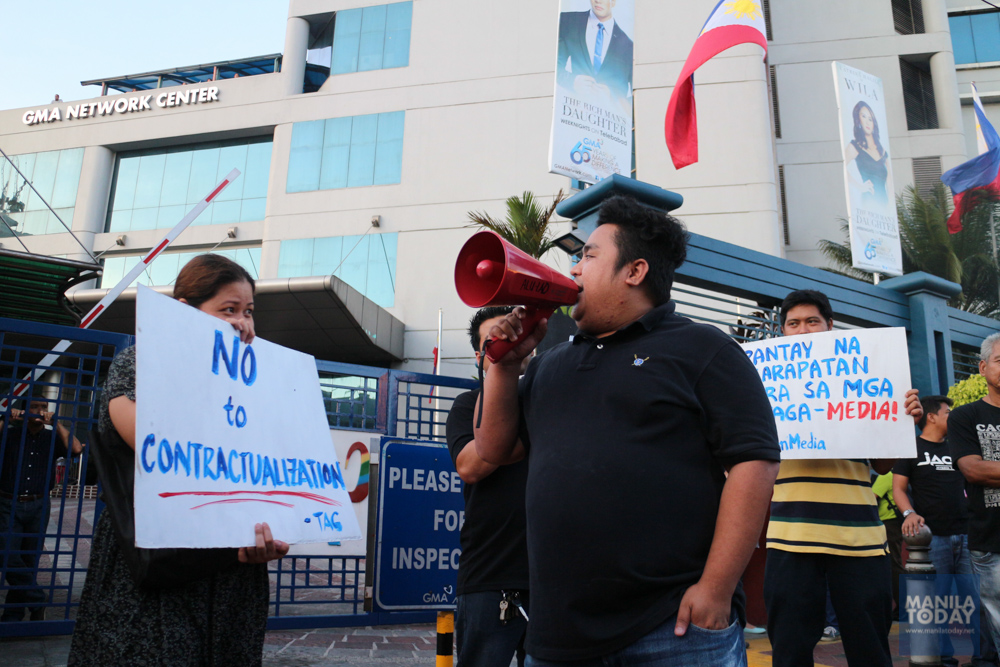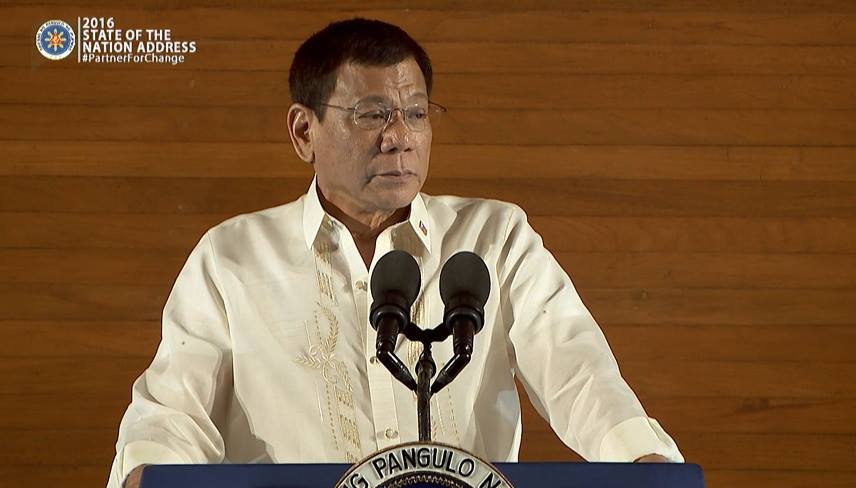More than two years ago, over 100 talents from media giant GMA organized themselves into an association, Talents Association of GMA Network (TAG), for want of better working conditions in their longtime jobs in the production departments of entertainment, news and public affairs programs. They believe their profession to be their dedication to public service, but it has been so at the expense of their welfare and safety.
Talents in the movie and television industry include workers in almost all posts in production, such as directors, segment producers, writers, researchers, edit supervisors, production coordinators, transcribers, etc. As talents, they are paid only for every episode aired and had “zero benefits”. Talents, despite doing essential work, were considered by the company as individual contractors rather than regular employees.
Two years ago, TAG filed a regularization complaint against GMA. Almost two years after, the National Labor Relations Commission (NLRC) in February 17 upheld its June and September 2015 decisions recognizing TAG complainants as regular employees as “final and executory.”
The legal victory is yet to be implemented, but GMA network is already set to appeal the NLRC decision before the Court of Appeals. As the talents have yet to experience the fruits of their struggle with their company, TAG continues to dream for a media industry free from contractualization. And for that, their fight goes on.
Timeline of GMA talents’ struggle for regularization
June 4, 2014 – TAG filed a case against GMA Network for unfair labor practice at the NLRC.
October 26, 2014 – TAG launched “Buhay Media” page on Facebook, its social media campaign to raise awareness on the plight of TV network talents. The page instantly became popular as it churned out witty and humorous memes on the realities of working in the media industry and heart-wringing stories of experiences and profiles of media workers.

November 4, 2014 – GMA introduced the Project Employment Contract (PEC) for all its existing talents. Talents must sign the PEC until November 4 or their contracts would not be renewed. PEC is the revamped version of the previous contract offered by GMA to its talents. The PEC would provide benefits to talents accorded to regular employees such as SSS, PAG-IBIG and Philhealth but does not provide regularization or security of tenure (expires in a year). It also included the provision of 13th month pay that would be sourced from equal monthly portions subtracted from the talent’s salary. TAG members and complainants in the case against GMA did not sign the PEC as it undermines the pending regularization case.
November 10, 2014 – TAG and GMA Network submitted their position papers detailing the facts and legal basis of their arguments with regard to the regularization complaint.
November 20, 2014 – TAG began its campus tour to educate college students and faculty about the realities behind the labor conditions of media workers in the Philippines.
December 31, 2015 – For not signing the PEC, the talents whose contracts expired in 2014 were either asked to no longer report for work or were not given new assignments, effectively dismissing them from work. On one hand, the media giant lost and was set to lose the key people in many of their programs and even the talents were puzzled how GMA would deal with a ‘possible breakdown’.
The GMA management was compelled to allow those who did not sign the PEC to continue until their contracts expire (some with as long as two years left in their contract) and to send out offers of promotions to current talents. GMA would possibly face another complaint, illegal dismissal, should it terminate talents who did not sign the PEC but have existing contracts.
At the end of the year, only 106 of the original 142 complainants continued with the case “due to various personal and work-related reasons”.
January 9, 2015 – Salaries of 52 dismissed TAG members for the period of December 16 to 31 were withheld. The network’s Production Administrators, who are in-charge of all the administrative matters concerning the talents, gave the reason that the Legal Department is following a “company policy that subjects talents to final clearance” for withholding their salaries. The lack of clearance had something to do with “unissued documents, such as resignation letters.” TAG members and complainants to the case again refused to issue resignation letters as it would again undermine the fight for regularization. It would also provide GMA legal basis to terminate or disallow from work talents with existing contracts.
Some dismissed talents were asked to go back to work prior to receiving their salary to beef up GMA’s work force after the terminations at the end of 2014.
February 10, 2015 – Rep. Emmi de Jesus & Rep. Luz Ilagan of Gabriela Women’s Partylist, together with Rep. Kit Belmonte of Quezon City (6th District) filed House Resolution 1893 urging for an investigation in aid of legislation to look into the situation of GMA-7 talents. Gabriela Women’s Partylist filed House Bill 4396 or the ‘Regular Employment Bill’ in May 2014, in efforts to prohibit contractual employment.

June 3, 2015 – TAG memberds lit candles and offered prayers at the Sacred Heart Parish in Quezon City. The gathering was called “Isang Kanila at Dasal para sa Kontraktwal” and was part of TAG’s campaign to raise awareness regarding labor injustice throughout the country.
TAG also decried the new network policy requiring talents to issue an acknowledgment receipt (AR) to the company upon receipt of their salary, effectively turning their “salary” into “fees.” To TAG, issuance or signing of the AR would mean “accepting the fact that we are not regular employees.”

June 5, 2015 – TAG staged a peaceful protest in front of GMA Network Center to condemn the harassment of its members and to call for an end in contractualization in the media industry.


June 25, 2015 – The NLRC handed down a resolution in favor of GMA talents. The labor arbiter ordered GMA to recognize 107 talents as regular employees and reinstate them. GMA filed an appeal against the NLRC decision on July 6.
In a 16-page resolution signed by Labor Arbiter Julio Gayaman on June 22, 2015, 107 talents were declared “regular employees of GMA Network Inc. and as such are entitled to security of tenure and all benefits and rights appurtenant thereto.”
July 8, 2015 – GMA dismissed 11 talents including TAG’s President Christian Cabaluna, who has worked for the network for nine years. GMA also dismissed other key members of TAG. TAG felt that “this harassment is the network’s reaction to the NLRC decision favorable to the talents”. This would give way to an illegal dismissal complaint filed by TAG later that year.
September 30, 2015 – Three months after the labor arbiter’s verdict, the Commissioner of the NLRC upheld the labor arbiter’s decision.
January 5, 2016 – NLRC Special Fourth Division denies the Motion for Reconsideration filed by GMA Network over the September 30, 2015 Decision favoring TAG. They find “no compelling justification or valid reason to modify, alter, much less reverse, the Decision sought to be reconsidered.”
February 17, 2016 – Almost two years since the case was filed, the NLRC has finally issued an Entry of Judgement declaring its September 30, 2015 decision as “final and executory”.
April 26, 2016 – In an NLRC-mediated meeting between TAG and GMA Network, the company’s lawyer said that although they do not agree with the decision, they will abide by it. However, GMA has filed an appeal at the Court of Appeals.
According to TAG’s legal counsel, TAG and GMA should meet at least twice before May 11 for the two parties to come to an agreement or to be able to declare that they could not come to an agreement. Another meeting is set on May 11.

































 In 1993, Ka Paeng was faced with the struggle within the national leadership of KMP on how to treat the government’s agrarian reform program. He affirmed that the peasant movement should continue to rely on its collective action and should not collaborate with the state in implementing a bogus agrarian reform program.
In 1993, Ka Paeng was faced with the struggle within the national leadership of KMP on how to treat the government’s agrarian reform program. He affirmed that the peasant movement should continue to rely on its collective action and should not collaborate with the state in implementing a bogus agrarian reform program.

 Ka Paeng is very articulate when it comes to agrarian laws and cases. In an interview, he mentioned that he persevered in reading all the case files of Hacienda Luisita, Hacienda Looc, Hacienda Roxas, Araneta Estates and many more including important court decisions; laws and Supreme Court decisions about agrarian reform since Commonwealth up to present; and memorandum circulars issued by the Department of Agrarian Reform (DAR).
Ka Paeng is very articulate when it comes to agrarian laws and cases. In an interview, he mentioned that he persevered in reading all the case files of Hacienda Luisita, Hacienda Looc, Hacienda Roxas, Araneta Estates and many more including important court decisions; laws and Supreme Court decisions about agrarian reform since Commonwealth up to present; and memorandum circulars issued by the Department of Agrarian Reform (DAR).
 In the absence of an Agrarian Reform Program for almost two years now, DAR cannot issue new Certificates of Land Ownership Awards (CLOAs) and Emancipation Patents (EPs) to farmer beneficiaries. Many CLOAs and EPs have been reportedly cancelled due to exemption and land use conversion. Congress failed to extend CARP with Extension and Reforms (CARPER) in 2014, leaving the country with fundamentally no land reform program for two years under the presidency of Benigno Aquino, son of Cory and criticized as “Haciendero president.”
In the absence of an Agrarian Reform Program for almost two years now, DAR cannot issue new Certificates of Land Ownership Awards (CLOAs) and Emancipation Patents (EPs) to farmer beneficiaries. Many CLOAs and EPs have been reportedly cancelled due to exemption and land use conversion. Congress failed to extend CARP with Extension and Reforms (CARPER) in 2014, leaving the country with fundamentally no land reform program for two years under the presidency of Benigno Aquino, son of Cory and criticized as “Haciendero president.”





 The talks have stalled in previous administrations because of GPH’s refusal to honor previously signed agreements.
The talks have stalled in previous administrations because of GPH’s refusal to honor previously signed agreements.
 In a statement by the Comval North Davao South Agusan Sub-Regional Command of the NPA, Aris Francisco, the spokesperson of the NPA command said that, “the ambush was in adherence to the directive of the NPA National Operations Command for Red fighters to maintain on alert status and on active defense mode in response to President Rodrigo Duterte’s declared unilateral ceasefire.”
In a statement by the Comval North Davao South Agusan Sub-Regional Command of the NPA, Aris Francisco, the spokesperson of the NPA command said that, “the ambush was in adherence to the directive of the NPA National Operations Command for Red fighters to maintain on alert status and on active defense mode in response to President Rodrigo Duterte’s declared unilateral ceasefire.”



























 Basahin ang rebyu ng libro
Basahin ang rebyu ng libro  Mas lalo kaming naging malapit ni Perper noong naging magkabatch kami sa pagpasok sa confraternity. Doon naging mas solid ang samahan naming lahat, hindi lang namin itinuring ang isa’t isa bilang magkatrabaho sa council, kundi bilang magkapatid na rin. Sa loob ng kapatiran, naging mas matatag ang aming mga prinsipyo.
Mas lalo kaming naging malapit ni Perper noong naging magkabatch kami sa pagpasok sa confraternity. Doon naging mas solid ang samahan naming lahat, hindi lang namin itinuring ang isa’t isa bilang magkatrabaho sa council, kundi bilang magkapatid na rin. Sa loob ng kapatiran, naging mas matatag ang aming mga prinsipyo.